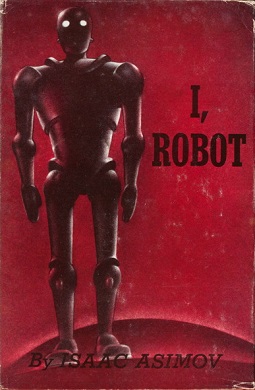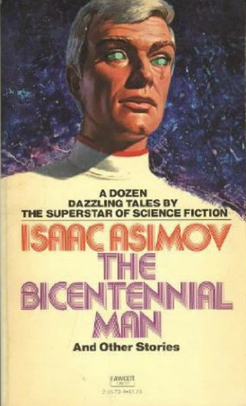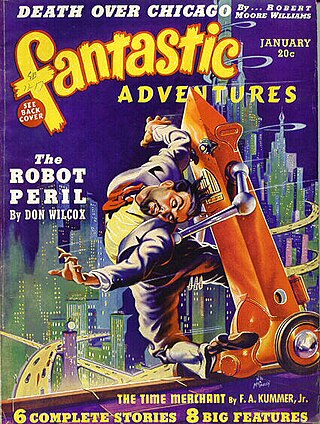This article needs additional citations for verification .(August 2015) |
The Frankenstein complex is a term coined by Isaac Asimov in his robot series, referring to the fear of mechanical men. [1]
This article needs additional citations for verification .(August 2015) |
The Frankenstein complex is a term coined by Isaac Asimov in his robot series, referring to the fear of mechanical men. [1]
Some of Asimov's science fiction short stories and novels predict that this suspicion will become strongest and most widespread in respect of "mechanical men" that most-closely resemble human beings (see android ), but it is also present on a lower level against robots that are plainly electromechanical automatons. [ citation needed ]
The "Frankenstein complex" is similar in many respects to Masahiro Mori's uncanny valley hypothesis.
The name, "Frankenstein complex", is derived from the name of Victor Frankenstein in the 1818 novel Frankenstein; or, The Modern Prometheus by Mary Shelley. In Shelley's story, Frankenstein created an intelligent, somewhat superhuman being, but he finds that his creation is horrifying to behold and abandons it. This ultimately leads to Victor's death at the conclusion of a vendetta between himself and his creation.
In much of his fiction, Asimov depicts the general attitude of the public towards robots as negative, with ordinary people fearing that robots will either replace them or dominate them, although dominance would not be allowed under the specifications of the Three Laws of Robotics, the first of which is:
However, Asimov's fictitious earthly public is not fully persuaded by this, and remains largely suspicious and fearful of robots. [ citation needed ] I, Robot 's short story "Little Lost Robot" is about this "fear of robots".
In Asimov's robot novels, the Frankenstein complex is a major problem for roboticists and robot manufacturers. They do all they can to reassure the public that robots are harmless, even though this sometimes involves hiding the truth because they think that the public would misunderstand it. The fear by the public and the response of the manufacturers is an example of the theme of paternalism, the dread of paternalism, and the conflicts that arise from it in Asimov's fiction. [ citation needed ]
The same theme occurs in many later works of fiction featuring robots, although it is rarely referred to as such.
Examples of human hostility towards robots have occurred in real life; for example, during a test of self-driving cars in Arizona, residents vandalized the vehicles. [2] [3]

An android is a humanoid robot or other artificial being often made from a flesh-like material. Historically, androids were completely within the domain of science fiction and frequently seen in film and television, but advances in robot technology now allow the design of functional and realistic humanoid robots.

I, Robot is a fixup collection made up of science fiction short stories by American writer Isaac Asimov. The stories originally appeared in the American magazines Super Science Stories and Astounding Science Fiction between 1940 and 1950 and were then collected into a 1950 publication Gnome Press in 1950, in an initial edition of 5,000 copies.

A robot is a machine—especially one programmable by a computer—capable of carrying out a complex series of actions automatically. A robot can be guided by an external control device, or the control may be embedded within. Robots may be constructed to evoke human form, but most robots are task-performing machines, designed with an emphasis on stark functionality, rather than expressive aesthetics.

The Three Laws of Robotics are a set of rules devised by science fiction author Isaac Asimov, which were to be followed by robots in several of his stories. The rules were introduced in his 1942 short story "Runaround", although similar restrictions had been implied in earlier stories.

Technophobia, also known as technofear, is the fear or dislike of, or discomfort with, advanced technology or complex devices, especially personal computers, smartphones, and tablet computers. Although there are numerous interpretations of technophobia, they become more complex as technology continues to evolve. The term is generally used in the sense of an irrational fear, but others contend fears are justified. It is the opposite of technophilia.
Artificial humans and autonomous artificial servants have a long history in human culture, though the term Robot and its modern literary conception as a mobile machine equipped with an advanced artificial intelligence are more fairly recent. The literary role of artificial life has evolved over time: early myths present animated objects as instruments of divine will, later stories treat their attempted creation as a blasphemy with inevitable consequences, and modern tales range from apocalyptic warnings against blind technological progress to explorations of the ethical questions raised by the possibility of sentient machines.
Science fiction is a film genre that uses speculative, fictional science-based depictions of phenomena that are not fully accepted by mainstream science, such as extraterrestrial lifeforms, spacecraft, robots, cyborgs, mutants, interstellar travel, time travel, or other technologies. Science fiction films have often been used to focus on political or social issues, and to explore philosophical issues like the human condition.

The Bicentennial Man is a novelette in the Robot series by American writer Isaac Asimov. According to the foreword in Robot Visions, Asimov was approached to write a story, along with a number of other authors who would do the same, for a science fiction collection to be published in honor of the United States Bicentennial. However, the arrangement fell through, leaving Asimov's the only story actually completed for the project. Asimov sold the story to Judy-Lynn del Rey, who made some small changes to the text. Asimov restored the original text when the story was collected in The Bicentennial Man and Other Stories (1976).
Robopsychology is the study of the personalities and behavior of intelligent machines. The term was coined by Isaac Asimov in the short stories collected in I, Robot, which featured robopsychologist Dr. Susan Calvin, and whose plots largely revolved around the protagonist solving problems connected with intelligent robot behaviour. The term has been also used in some academic studies from the field of psychology and human–computer interactions, and it refers to the study of the psychological consequences of living in societies where the application of robotics is becoming increasingly common.
"Robbie" is a science fiction short story by American writer Isaac Asimov. It was the first of Asimov's positronic robot stories. In 2016, "'Robbie" won a retrospective 1941 Hugo Award for best short story. "Robbie" was the fourteenth story written by Asimov, and the ninth to be published. It was the first story in Asimov's Robot series.
"Little Lost Robot" is a science fiction short story by American writer Isaac Asimov. It was first published in the March 1947 issue of Astounding Science Fiction and reprinted in the collections I, Robot (1950), The Complete Robot (1982), Robot Dreams (1986), and Robot Visions (1990).

I, Robot is a 2004 American science fiction action film directed by Alex Proyas. The screenplay by Jeff Vintar and Akiva Goldsman is from a screen story by Vintar, based on his original screenplay Hardwired, and named after Isaac Asimov's 1950 short-story collection. The film stars Will Smith in the main role, Bridget Moynahan, Bruce Greenwood, James Cromwell, Chi McBride, and Alan Tudyk. Set in Chicago in 2035, highly intelligent robots fill public service positions throughout the world, operating under three laws to keep humans safe. Detective Del Spooner (Smith) investigates the alleged suicide of U.S. Robotics founder Alfred Lanning (Cromwell) and believes that a human-like robot called Sonny (Tudyk) murdered him.

An AI takeover is a scenario in which artificial intelligence (AI) becomes the dominant form of intelligence on Earth, as computer programs or robots effectively take control of the planet away from the human species. Possible scenarios include replacement of the entire human workforce due to automation, takeover by a superintelligent AI, and the popular notion of a robot uprising. Stories of AI takeovers are popular throughout science fiction. Some public figures, such as Stephen Hawking and Elon Musk, have advocated research into precautionary measures to ensure future superintelligent machines remain under human control.

Tik-Tok is a 1983 science fiction novel by American writer John Sladek. It received a 1983 British Science Fiction Association Award.
References to Isaac Asimov's Three Laws of Robotics have appeared in a wide variety of circumstances. In some cases, other authors have explored the Laws in a serious fashion. Other references, like those made in the satirical newspaper The Onion, are clearly parodic.
Artificial intelligence is a recurrent theme in science fiction, whether utopian, emphasising the potential benefits, or dystopian, emphasising the dangers.

Robotics is the branch of technology that deals with the design, construction, operation, structural disposition, manufacture and application of robots. Robotics is related to the sciences of electronics, engineering, mechanics, and software.
The following outline is provided as an overview of and topical guide to robotics:

AI takeover—the idea that some kind of artificial intelligence may supplant humankind as the dominant intelligent species on the planet—is a common theme in science fiction. Famous cultural touchstones include Terminator and The Matrix.
{{cite book}}: |first1= has generic name (help)CS1 maint: multiple names: authors list (link)